How to Upload 3d Mesh to Cloud
3D Python
5-Footstep Guide to generate 3D meshes from point clouds with Python
Tutorial to generate 3D meshes (.obj, .ply, .stl, .gltf) automatically from 3D signal clouds using python. (Bonus) Surface reconstruction to create several Levels of Particular.
In this article, I will requite you my 3D surface reconstruction process for quickly creating a mesh from bespeak clouds with python. You lot volition be able to consign, visualize and integrate results into your favorite 3D software, without whatever coding experience. Additionally, I will provide you with a simple fashion to generate multiple Levels of Details (LoD), useful if you want to create existent-fourth dimension applications (E.g. Virtual Reality with Unity).
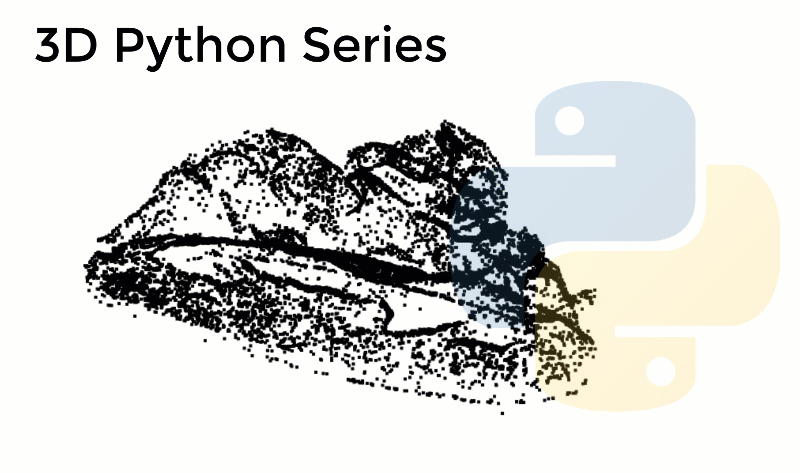
3D meshes are geometric data structures most often composed of a agglomeration of connected triangles that explicitly describe a surface 🤔. They are used in a wide range of applications from geospatial reconstructions to VFX, movies and video games. I frequently create them when a physical replica is demanded or if I need to integrate environments in game engines, where point cloud support is express.
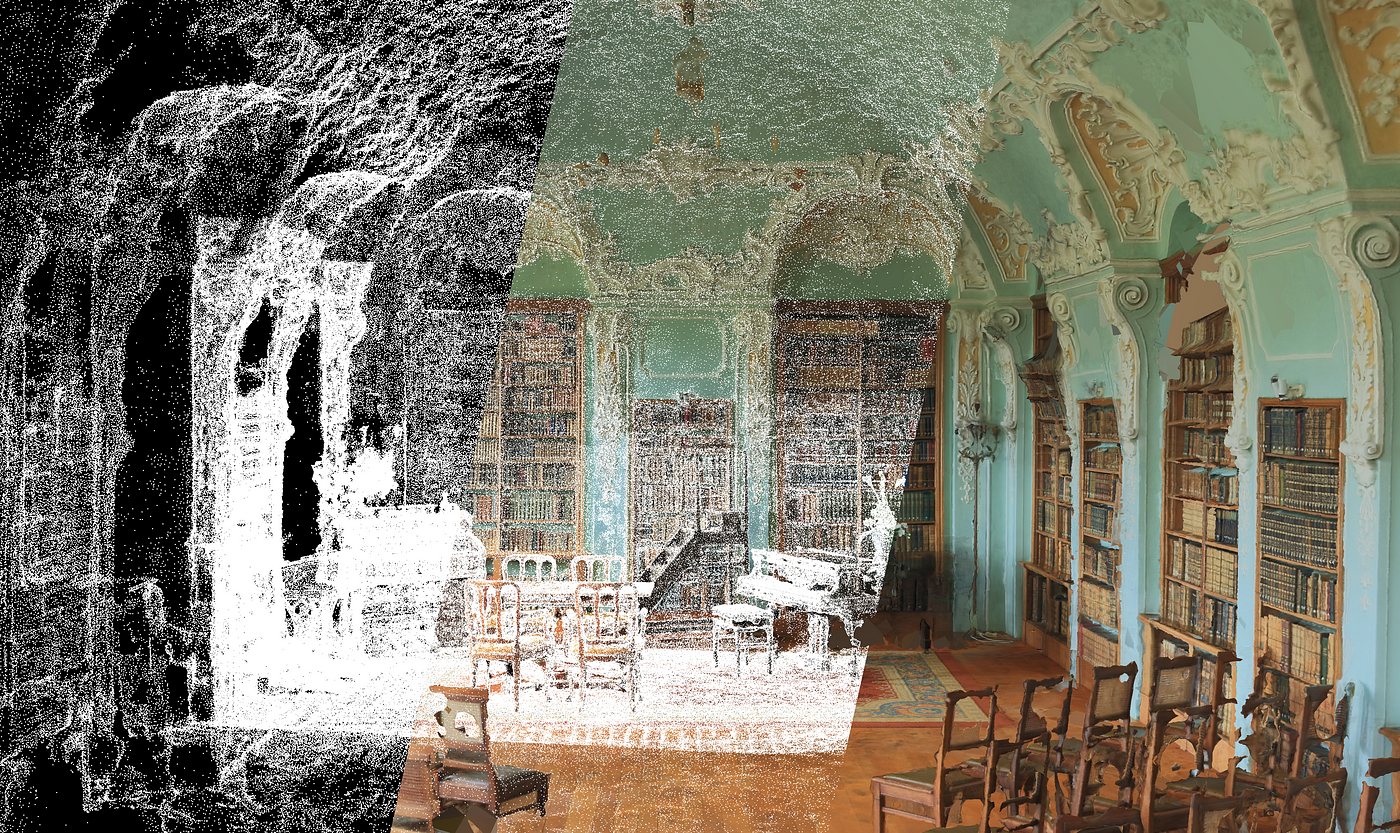
They are well integrated in almost of the software professionals work with. On top, if you want to explore the wonder of 3D press, you need to be able to generate a consequent mesh from the data that you have. This commodity is designed to offer you an efficient workflow in 5 customizable steps along with my script remotely executable at the stop of the article. Let us dive in!
Step 1: Setting upward the environment
In the previous commodity, we saw how to set-up an surroundings easily with Anaconda, and how to employ the GUI Spyder for managing your code. Nosotros volition go on in this fashion, using only ii libraries.
For getting a 3D mesh automatically out of a point cloud, we volition add some other library to our environment, Open3D. It is an open up-source library that allows the use of a set of efficient data structures and algorithms for 3D information processing. The installation necessitates to click on the ▶️ icon next to your environment.
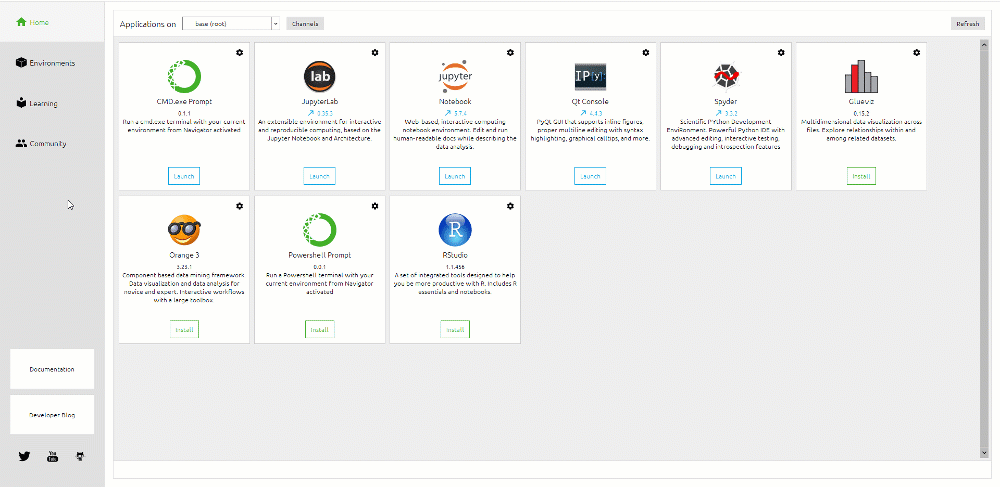
Open the Concluding and run the post-obit command:
conda install -c open3d-admin open3d==0.8.0.0 🤓 Note : The Open3D package is compatible with python version 2.7, 3.5 and 3.vi. If yous have another, you can either create a new environment (best) or if you start from the previous article, change the python version in your last by typing conda install python=iii.5 in the Terminal.
This will install the packet and its dependencies automatically, yous can but input y when prompted in the last to allow this procedure. You are now ready-upwardly for the project.
Step 2: Load and gear up the information
Launch your python scripting tool (Spyder GUI, Jupyter or Google Colab), where nosotros volition telephone call 2 libraries: Numpy and Open3D.
import numpy as np
import open3d as o3d Then, we create variables that concord information paths and the betoken cloud data:
input_path="your_path_to_file/"
output_path="your_path_to_output_folder/"
dataname="sample.xyz"
point_cloud= np.loadtxt(input_path+dataname,skiprows=1) 🤓 Note : As for the previous mail, we will utilise a sampled point deject that you tin can freely download from this repository. If you want to visualize it beforehand without installing anything, yous can bank check the webGL version.
Finally, we transform the point_cloud variable type from Numpy to the Open3D o3d.geometry.PointCloud type for further processing:
pcd = o3d.geometry.PointCloud()
pcd.points = o3d.utility.Vector3dVector(point_cloud[:,:iii])
pcd.colors = o3d.utility.Vector3dVector(point_cloud[:,iii:vi]/255)
pcd.normals = o3d.utility.Vector3dVector(point_cloud[:,6:9]) 🤓 Notation : The following command kickoff instantiates the Open3d point cloud object, so add together points, color and normals to it from the original NumPy array.
For a quick visual of what yous loaded, you can execute the following command (does not work in Google Colab):
o3d.visualization.draw_geometries([pcd]) Step 3: Choose a meshing strategy
Now we are set up to starting time the surface reconstruction process past meshing the pcd point cloud. I volition give my favorite mode to efficiently obtain results, but before we dive in, some condensed details ar necessary to grasp the underlying processes. I will limit myself to two meshing strategies.
Strategy 1: Ball-Pivoting Algorithm [i]
The thought behind the Brawl-Pivoting Algorithm (BPA) is to simulate the utilise of a virtual brawl to generate a mesh from a point cloud. We kickoff assume that the given betoken deject consists of points sampled from the surface of an object. Points must strictly represent a surface (racket-free), that the reconstructed mesh explicit.
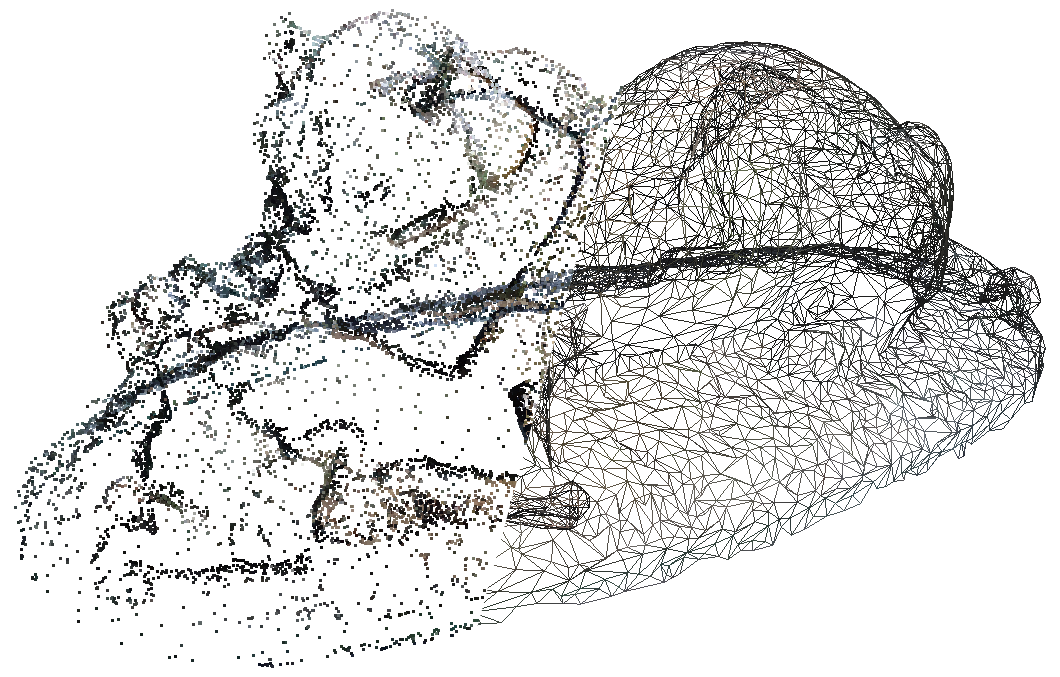
Using this assumption, imagine rolling a tiny ball across the point cloud "surface". This tiny ball is dependent on the scale of the mesh, and should be slightly larger than the average space between points. When yous drop a ball onto the surface of points, the ball volition get caught and settle upon three points that will grade the seed triangle. From that location, the ball rolls along the triangle edge formed from two points. The ball then settles in a new location: a new triangle is formed from 2 of the previous vertices and i new triangle is added to the mesh. As nosotros continue rolling and pivoting the ball, new triangles are formed and added to the mesh. The brawl continues rolling and rolling until the mesh is fully formed.

The idea behind the Ball-Pivoting Algorithm is unproblematic, but of course, there are many caveats to the procedure equally originally expressed here:
- How is the ball radius chosen? The radius, is obtained empirically based on the size and scale of the input point deject. In theory, the bore of the ball should be slightly larger than the average distance between points.
- What if the points are too far apart at some locations and the ball falls through? When the ball pivots along an edge, it may miss the appropriate point on the surface and instead striking another point on the object or even exactly its iii old points. In this case, nosotros bank check that the normal of the new triangle
Facetis consistently oriented with the point'due southVertexnormals. If it is not, then nosotros refuse that triangle and create a hole. - What if the surface has a pucker or valley, such that the distance between the surface and itself is less than the size of the ball? In this case, the ball would but scroll over the crease and ignore the points within the crease. Merely, this is not ideal behavior as the reconstructed mesh is non accurate to the object.
- What if the surface is spaced into regions of points such that the ball cannot successfully roll between the regions? The virtual ball is dropped onto the surface multiple times at varying locations. This ensures that the ball captures the unabridged mesh, even when the points are inconsistently spaced out.
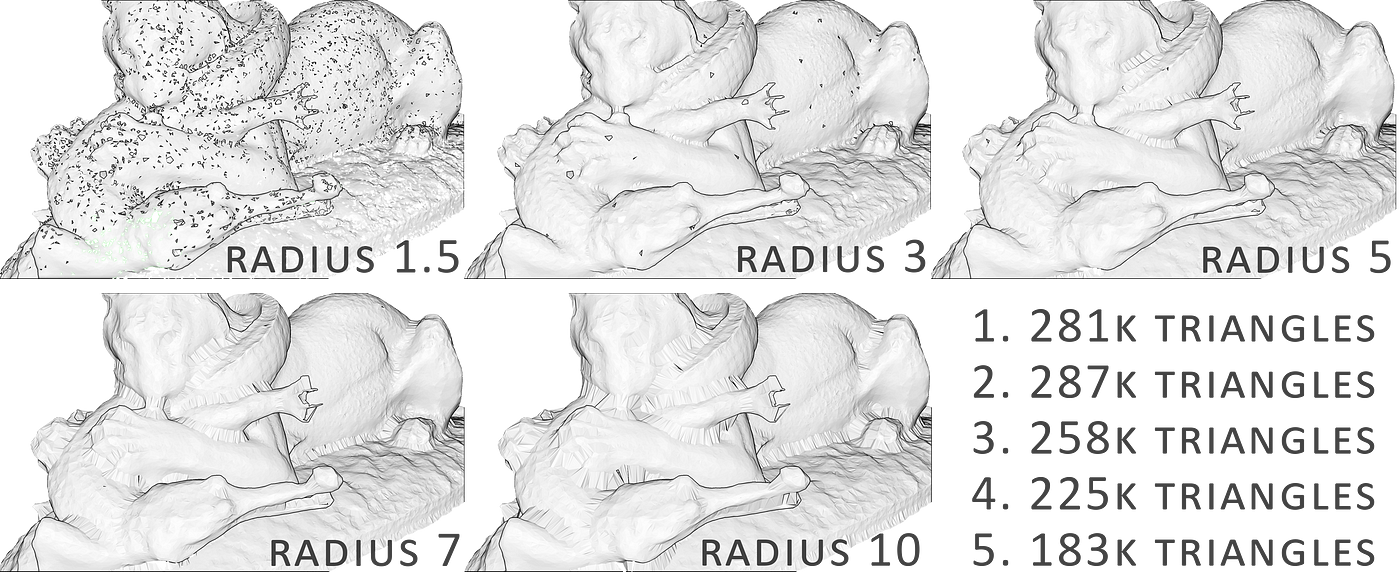
Strategy two: Poisson reconstruction [2]
The Poisson Reconstruction is a chip more than technical/mathematical. Its approach is known as an implicit meshing method, which I would describe equally trying to "envelop" the information in a smooth fabric. Without going into likewise many details, we attempt to fit a watertight surface from the original betoken set past creating an entirely new point gear up representing an isosurface linked to the normals. In that location are several parameters available that affect the upshot of the meshing:
- Which depth? a tree-depth is used for the reconstruction. The higher the more detailed the mesh (Default: eight). With noisy data you go on vertices in the generated mesh that are outliers but the algorithm doesn't detect them equally such. And so a low value (maybe betwixt v and 7) provides a smoothing effect, only you lot will lose detail. The higher the depth-value the higher is the resulting amount of vertices of the generated mesh.
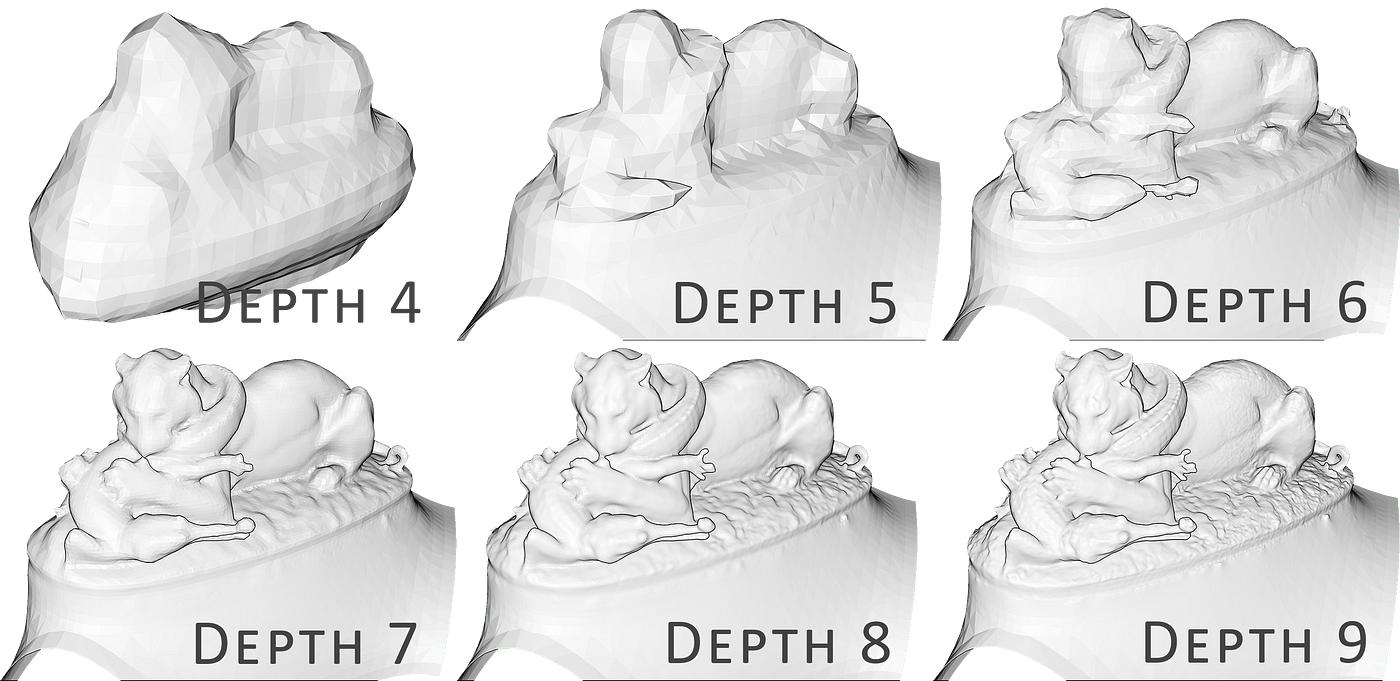
- Which width? This specifies the target width of the finest level of the tree construction, which is called an octree 🤯. Don't worry, I will cover this and best information structures for 3D in another article equally information technology extends the scope of this one. Anyway, this parameter is ignored if the depth is specified.
- Which scale? It describes the ratio between the diameter of the cube used for reconstruction and the diameter of the samples' bounding cube. Very abstruse, the default parameter usually works well (1.ane).

- Which fit? the linear_fit parameter if gear up to truthful, let the reconstructor utilize linear interpolation to approximate the positions of iso-vertices.
Step 4: Procedure the data
Strategy 1: BPA
We showtime compute the necessary radius parameter based on the average distances computed from all the distances between points:
distances = pcd.compute_nearest_neighbor_distance()
avg_dist = np.mean(distances)
radius = iii * avg_dist In ane command line, we can then create a mesh and store it in the bpa_mesh variable:
bpa_mesh = o3d.geometry.TriangleMesh.create_from_point_cloud_ball_pivoting(pcd,o3d.utility.DoubleVector([radius, radius * two])) Before exporting the mesh, nosotros tin can downsample the result to an acceptable number of triangles, for case, 100k triangles:
dec_mesh = mesh.simplify_quadric_decimation(100000) Additionally, if you call up the mesh can present some weird artifacts, you tin can run the following commands to ensure its consistency:
dec_mesh.remove_degenerate_triangles()
dec_mesh.remove_duplicated_triangles()
dec_mesh.remove_duplicated_vertices()
dec_mesh.remove_non_manifold_edges() Strategy two: Poisson' reconstruction
🤓 Note : The strategy is bachelor starting the version 0.9.0.0 of Open3D, thus, information technology will only piece of work remotely at the moment. You can execute it through my provided google colab lawmaking offered here .
To become results with Poisson, it is very straightforward. Yous only have to accommodate the parameters that you laissez passer to the role as described to a higher place:
poisson_mesh = o3d.geometry.TriangleMesh.create_from_point_cloud_poisson(pcd, depth=8, width=0, scale=i.i, linear_fit=Simulated)[0] 🤓 Note : The office output a listing composed of an o3d.geometry object followed by a Numpy array. You want to select only the o3d.geometry justifying the [0] at the stop.
To become a make clean consequence, it is ofttimes necessary to add together a cropping step to make clean unwanted artifacts highlighted equally yellow from the left image beneath:

For this, nosotros compute the initial bounding-box containing the raw betoken cloud, and we employ it to filter all surfaces from the mesh outside the bounding-box:
bbox = pcd.get_axis_aligned_bounding_box()
p_mesh_crop = poisson_mesh.ingather(bbox) You at present accept one or more than variables that each hold the mesh geometry, well Well washed! The final step to get it in your application is to export it!
Pace 5: Export and visualize
Exporting the information is straightforward with the write_triangle_mesh function. We but specify inside the name of the created file, the extension that we desire from .ply, .obj, .stl or .gltf, and the mesh to export. Below, nosotros consign both the BPA and Poisson'southward reconstructions as .ply files:
o3d.io.write_triangle_mesh(output_path+"bpa_mesh.ply", dec_mesh)
o3d.io.write_triangle_mesh(output_path+"p_mesh_c.ply", p_mesh_crop) To rapidly generate Levels of Details (LoD), allow us write your offset function. It will exist really simple. The role will take as parameters a mesh, a listing of LoD (as a target number of triangles), the file format of the resulting files and the path to write the files to. The part (to write in the script) looks like this:
def lod_mesh_export(mesh, lods, extension, path):
mesh_lods={}
for i in lods:
mesh_lod = mesh.simplify_quadric_decimation(i)
o3d.io.write_triangle_mesh(path+"lod_"+str(i)+extension, mesh_lod)
mesh_lods[i]=mesh_lod
print("generation of "+str(i)+" LoD successful")
return mesh_lods 💡 Hint: I will comprehend the nuts of what the function does and how it is structured in some other commodity. At this point, it is useful to know that the function will (one) export the information to a specified location of your choice in the desire file format, and (2) give the possibility to shop the results in a variable if more processing is needed within python.
The function makes some magic, only once executed, it looks like cipher happens. Don't worry, your programme now knows what lod_mesh_export is, and you lot tin can directly call it in the panel, where we just change the parameters past the desired values:
my_lods = lod_mesh_export(bpa_mesh, [100000,50000,10000,1000,100], ".ply", output_path) What is very interesting, is that now you don't need to rewrite a agglomeration of lawmaking every time for different LoDs. You just accept to pass different parameters to the function:
my_lods2 = lod_mesh_export(bpa_mesh, [8000,800,300], ".ply", output_path) If you want to visualize within python a specific LoD, let united states of america say the LoD with 100 triangles, you lot can access and visualize it through the command:
o3d.visualization.draw_geometries([my_lods[100]]) To visualize exterior of python, y'all can use the software of your choosing (E.g Open-source Blender, MeshLab and CloudCompare) and load exported files within the GUI. Direct on the web through WebGL, yous can use Three.js editor or Flyvast to only access the mesh besides.
Finally, you tin import it in any 3D printing software and become quotations about how much information technology would cost through online press services 🤑.
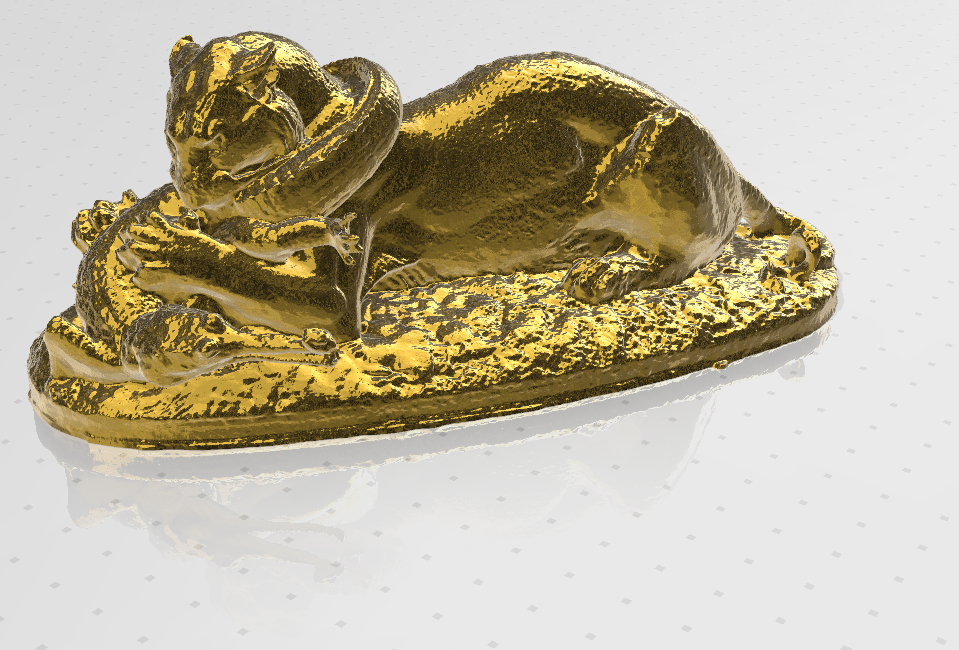
Bravo. In this 5-Step guide, we covered how to set-upwardly an automatic python 3D mesh creator from a point cloud. This is a very overnice tool that will prove very handy in many 3D automation projects! Nevertheless, we causeless that the indicate deject is already noise-free, and that the normals are well-oriented.
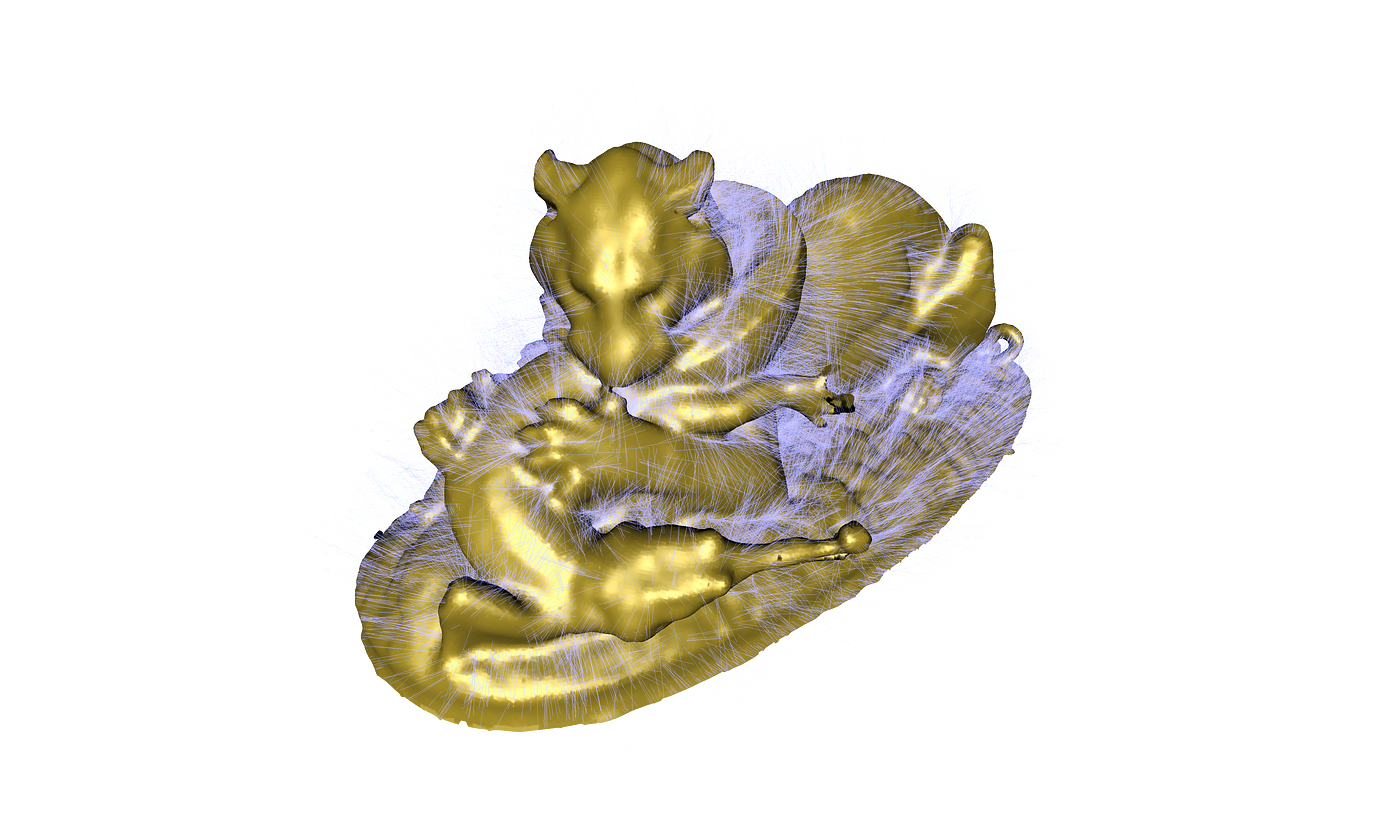
If this is not the instance, then some additional steps are needed and some nifty insights already discussed in the article below volition be cover in another article
The full code is accessible here: Google Colab notebook
Determination
You just learned how to import, mesh, export and visualize a signal cloud composed of millions of points, with dissimilar LoD! Well done! Just the path does not stop here, and future posts will swoop deeper in point deject spatial analysis, file formats, data structures, visualization, animation and meshing. We will especially look into how to manage big point cloud data as divers in the commodity below.
My contributions aim to condense actionable information so you lot tin can get-go from scratch to build 3D automation systems for your projects. You can get started today by taking a formation at the Geodata Academy
References
1. Bernardini, F.; Mittleman, J.; Rushmeier, H.; Silva, C.; Taubin, Chiliad. The ball-pivoting algorithm for surface reconstruction. Transactions on Visualization and Calculator Graphics 1999, 5, 349–359.
2. Kazhdan, M.; Bolitho, 1000.; Hoppe, H. Poisson surface reconstruction. Eurographics symposium on Geometry processing 2006, i–ten.
Source: https://towardsdatascience.com/5-step-guide-to-generate-3d-meshes-from-point-clouds-with-python-36bad397d8ba
0 Response to "How to Upload 3d Mesh to Cloud"
Post a Comment